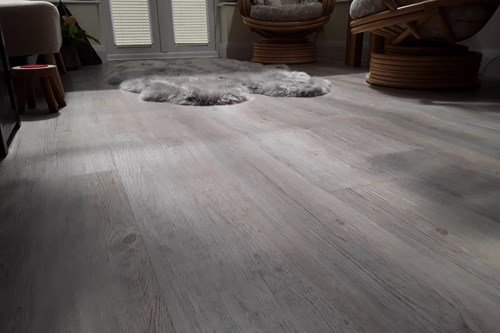As Bob the Builder continues his trail of destruction, Sid explains why prolonged direct sunlight is harmful to luxury vinyl planks and tiles.
IN this column I’ve put together what I hope is useful information regarding luxury vinyl planks and tiles. My complaint rate has trebled for LVT, mainly owing to Bob the Builder now installing these but also because of mistakes made by professionals in the flooring trade.
One of the biggest complaints is owing to direct sunlight entering through large glass doors and windows where the floor buckles. I don’t believe anyone goes out with the intention of installing a flooring that’s going to fail, but rather because they have a lack of knowledge and understanding of the product, and the installation of the product.
So I’ve put together this article to try to help people avoid the obvious mistakes I see on a daily basis.
My floor is buckling. Why?
When you want the luxurious look of hardwood or natural stone without the hefty price tag, LVT flooring is an obvious option. This cost-effective alternative to hardwood and natural stone flooring comes in a wide range of colours and designs and is relatively easy to install and maintain. LVT flooring typically requires a click-together locking system, is a loose-lay, or is fully adhered to the subfloor.
However, if not properly thought about and correctly installed the floorcovering may experience buckling or distortion after installation. Sometimes the causes are overlooked or misunderstood. There are newer LVT products entering the market, enhanced click or rigid click, stone plastic composite (SPC), wood plastic composite (WPC) and engineered. All are plastic or vinyl based and all will expand and contract.
What causes buckling and distortion?
Buckling can occur with click-together, loose-lay, or fully adhered LVT. There are a handful of reasons that can cause this issue. Understanding the reasons for buckling and failure can help avoid the problem and costly replacement.
One major cause of buckling of loose laid, click-together, loose lay and adhered LVT is direct sunlight shining through unprotected glass, causing a localised hot area on the surface of the LVT. Being vinyl, the LVT will expand when heated and contract when cooled. Excessive heat, normally from south facing windows, will expand and buckle the floorcovering. Even adhered LVT can be damaged if the wrong type of adhesive is selected. For adhered LVT high temperature adhesive should be selected for these types of area.
Heat from direct sunlight is one of the most common causes of loose-laid LVT buckling. Prevent this from happening by taking steps to protect sections of the flooring from nearby windows. Applying a UV protection film or glass tint directly to the windows helps limit the heat and light transfer through the window.
Hanging blackout blinds or thermal curtains is another way to limit the effect on floors near adjacent windows. This also protects the floorcovering, furniture and other soft furnishings from becoming damaged or faded by UV light.
Click-together and loose-lay LVT have become a very quick and convenient method of installation. It’s important to allow for the manufacturers recommended movement or expansion gap all the way around the perimeter and against any upstand. Rises and falls in the ambient room temperature will expand and contract the product, the whole area will want to move. This free movement is a requirement of the product system and it must not be restricted in any way. Fixing through the product or fitting a heavy kitchen island on-top of the flooring will stop it moving, causing buckling when it wants to move.
Adhered LVT can also be affected by high levels of heat, high temperature adhesives should be used and recommended in these areas. Although the LVT floorcovering itself is water resistant the adhesive may not be, so water ingress into the joints from excessive cleaning, leaks or spills may affect the adhesive and the bond, as will retained or rising moisture from the subfloor. Cupping, tenting and buckling can be an effect of moisture ingress or moisture related failure.
Natural wood and laminate floorcoverings with plywood or MDF backings are relatively non-conductive and are very limited in the amount of movement created from the effect of heat. These types of floorcovering are affected by water, moisture or humidity. Commonly, these types of floorcovering are completely avoided in bathrooms and kitchens.
Vinyl-based LVT is the exact opposite, unaffected by water, moisture or humidity it is affected by variations in temperature. LVT is generally recommended for all areas, although direct sunlight shining directly on looselay floorcovering systems should be avoided.
I hope this explanation helps prevent people like me writing a negative report on the installation and cause of failure, and prevents you having to replace the flooring because you never considered what direct sunlight can do to LVT/LVP until it’s too late. It’s imperative to choose the correct installation method, LVT/LVP product and adhesive if required, to avoid such problems.


